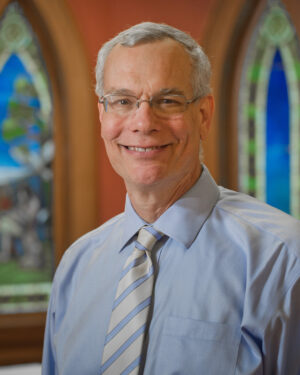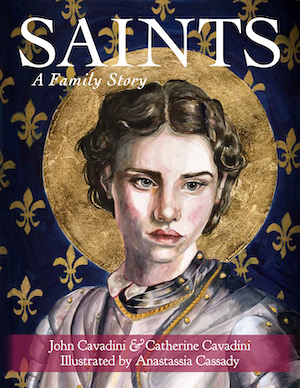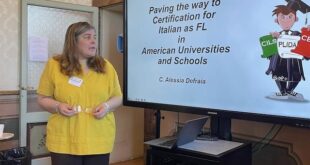A man of faith as well as letters, John Cavadini teamed up with his daughter to co-author a book that makes the lives of saints accessible to young and old alike.
“Saints: A Family Story” is a collection of affectionately told and gorgeously illustrated narratives of 34 holy men and women.
The title is fitting, given that the saints are “presented as a ‘Family,’ living in many different times and places,” according to the authors, the father-daughter team of John and Catherine (Katie) Cavadini, who wrote the book for friends and family.

While the book is written for children, its substantive content and vivid illustrations are meant to captivate all ages. The authors bring superlative academic credentials to the task.
John Cavadini is a professor of theology and director of the McGrath Institute for Church Life at the University of Notre Dame. A prolific author, he was knighted by Pope Benedict XVI for his service to the Church. Katie Cavadini is a teaching professor and director of the Master of Arts in theology program at the University of Notre Dame.
The authors launch the book with a portrait of St. John Paul II, explaining that “he called the Church today to sanctity by giving us the gift of more and more saints,” and noting that he canonized 482 and beatified 1,300 worthy candidates.
 Then they take us on a journey throughout the centuries and around the world. Along the way, we meet the world renowned (St. Joseph and St. Luke the Evangelist), lesser known (St. Macrina the Elder and Blessed Herman of Reichenau) and recently designated (Blessed Pier Giorgio Frassati and St. Gianna Molla).
Then they take us on a journey throughout the centuries and around the world. Along the way, we meet the world renowned (St. Joseph and St. Luke the Evangelist), lesser known (St. Macrina the Elder and Blessed Herman of Reichenau) and recently designated (Blessed Pier Giorgio Frassati and St. Gianna Molla).
Short chapters typically unfold in a storytelling style. For instance, we learn at the beginning of John the Baptist’s tale that “St. John did not live in a house.” The accounts are sprinkled with fascinating details. The authors mention, for example, that when St. Catherine of Siena spoke bravely to the pope, she addressed him as “Dad” instead of “Your Holiness.”
The book’s stunning illustrations are the work of a longtime family friend of the Cavadinis, Anastassia (Tess) Cassady, a Byzantine Catholic trained in “writing” icons. (Icons are written, not painted, since they are meant to tell a story: in other words, “Scripture in visual form.”)
I spoke to John Cavadini about the approach he and his daughter took to the topic, and how he combined his extensive knowledge of Church history with his passion for what he calls the “beautiful task” of telling the stories about saints in a family setting.
Ron Polaniecki: Tell us about your Italian lineage and how it influenced your book, particularly the “family” theme.
John Cavadini: On my father’s side, my grandmother was from Piedmont and my grandfather from Milan. And on my mother’s side, my grandmother was from Naples and my grandfather from Palermo. So, since my family is from the whole peninsula, you could say that I’m a bit like Victor Emmanuel II, who is remembered as the king who united all of Italy.
The Italian cultural, spiritual idea of family was passed on to me. And it lives on with my seven children and 18 grandchildren, who all are in the area. You could say we are very tight.
RP: How does writing scholarly articles on theology for an academic audience differ from writing a book aimed at families?
JC: They are not incredibly different. As a theologian, I consider, as a practical matter, how is my writing going to affect the teaching, preaching and proclaiming of the faith beyond the academic world? Theologians should make their writing intelligible to believers and nonbelievers alike, people who may have left the practice of the faith or are thinking of leaving it. Good theology should help them to reconsider. Good theology is attractive and interesting, not dry, sterile or irrelevant. So, the aims of my scholarly work are not that different from the aims of this book.
RP: The Catholic Church archives include approximately 11,000 saints. How did you select just 34?
JC: In brief, my family made the selections. This did not start as a book project, but rather grew out of a little game that I played with my grandkids. Guided by calendar feast days, I produced drawings and stories of saints on cards. I put these baseball-type cards in envelopes and distributed them to my grandchildren during Sunday dinner visits. One time, for fun, I put “coupons” into the envelopes, which could be redeemed for a card about a saint of their choice. To my surprise, many redeemed those coupons. Some chose their own names, others the names of their parents. This meant that now I had to write stories about these saints.
One grandson requested a story about St. Luke, his namesake. This was a challenge since we don’t know much about this evangelist. However, we do know that St. Luke was an adventurer and that he was shipwrecked and had to swim through a stormy sea to safety. All this, to spread the Gospel. Now, that’s interesting. And my grandson liked it.
As I wrote these saint stories, my daughter, Katie, suggested we put them in a book. Then Katie asked Tess Cassady, her friend and former fellow swim-team member from school, to create artwork. Tess took the challenge “super seriously,” conducted extensive research and created beautiful illustrations filled with symbolism.
RP: How was it to work with Katie, a fellow theologian, and your daughter?
JC: It was a pleasure as we have a synergy of talents and gifts. Katie has four children and is extremely organized, which sometimes I am not. To her credit, it was Katie who contributed lives of additional contemporary saints to round out what would become the book, also adding saints to balance the stories between young and old, men and women.
RP: What are you like as a grandpa?
JC: Of course, I love all my grandchildren. And I get up early every day to pray for all of them. I like to think I am kind of a wisdom figure — but not one who is too serious.
RP: Who are your favorite saints?
JC: Among my favorites are Cosmas and Damian, twin brothers born around 250. They had wealthy parents, beautiful homes and became doctors. But unlike some of those in their time and in our own, they were not obsessed with prestige and wealth. In contrast, they used their healing skills to help and comfort the poor. They never took any money from anyone. I want young people to know how these brothers gave of themselves. (For being Christians and spreading the Gospel, they were martyred by Diocletian around the year 300.)
RP: What’s next?
JC: The response to this book has been so positive that we’re considering a book about American saints, including, of course, Italian-American saints!
“Saints: A Family Story” is published by Paraclete Press. For more, clic here.
The above appears in the February 2024 issue of the print version of Fra Noi. Our gorgeous, monthly magazine contains a veritable feast of news and views, profiles and features, entertainment and culture. To subscribe, click here.
 Fra Noi Embrace Your Inner Italian
Fra Noi Embrace Your Inner Italian






Great to learn more about how such a wonderful book was written!